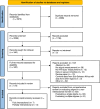Scoping review of HIV-related intersectional stigma among sexual and gender minorities in sub-Saharan Africa
- PMID: 38346887
- PMCID: PMC10862343
- DOI: 10.1136/bmjopen-2023-078794
Scoping review of HIV-related intersectional stigma among sexual and gender minorities in sub-Saharan Africa
Abstract
Objectives: Sexual and gender minority (SGM) populations in sub-Saharan Africa (SSA) are disproportionately impacted by HIV and often face multiple HIV-related stigmas. Addressing these stigmas could reduce SGM HIV vulnerability but little is known about how the stigmas operate and intersect. Intersectional stigma offers a lens for understanding the experiences of stigmatised populations and refers to the synergistic negative health effects of various systems of oppression on individuals with multiple stigmatised identities, behaviours or conditions. This review aims to (1) assess how often and in what ways an intersectional lens is applied in HIV-related stigma research on SGM populations in SSA and (2) understand how intersectional stigma impacts HIV risk in these populations.
Design: Scoping review following the Preferred Reporting Items for Systematic Reviews and Meta-Analysis extension for Scoping Reviews.
Data sources: Public health and regional databases were searched in 2020 and 2022.
Eligibility criteria: Articles in French and English on HIV-related stigma and HIV outcomes among men who have sex with men, women who have sex with women and/or transgender individuals in SSA.
Data extraction and synthesis: Articles were screened and extracted twice and categorised by use of an intersectional approach. Study designs and stigma types were described quantitatively and findings on intersectional stigma were thematically analysed.
Results: Of 173 articles on HIV-related stigma among SGM in SSA included in this review, 21 articles (12%) applied an intersectional lens. The most common intersectional stigmas investigated were HIV and same-sex attraction/behaviour stigma and HIV, same-sex attraction/behaviour and gender non-conformity stigma. Intersectional stigma drivers, facilitators and manifestations were identified across individual, interpersonal, institutional and societal socioecological levels. Intersectional stigma impacts HIV vulnerability by reducing HIV prevention and treatment service uptake, worsening mental health and increasing exposure to HIV risk factors.
Conclusion: Intersectional approaches are gaining traction in stigma research among SGM in SSA. Future research should prioritise quantitative and mixed methods investigations, diverse populations and intervention evaluation.
Keywords: HIV & AIDS; MENTAL HEALTH; Sexual and Gender Minorities; Sexually Transmitted Disease; Transgender Persons.
© Author(s) (or their employer(s)) 2024. Re-use permitted under CC BY-NC. No commercial re-use. See rights and permissions. Published by BMJ.
Conflict of interest statement
Competing interests: None declared.
Figures


Similar articles
-
Intersectional stigma and its impact on HIV prevention and care among MSM and WSW in sub-Saharan African countries: a protocol for a scoping review.BMJ Open. 2021 Aug 6;11(8):e047280. doi: 10.1136/bmjopen-2020-047280. BMJ Open. 2021. PMID: 34362801 Free PMC article.
-
Intersectional Stigma and Implementation of HIV Prevention and Treatment Services for Adolescents Living with and at Risk for HIV: Opportunities for Improvement in the HIV Continuum in Sub-Saharan Africa.AIDS Behav. 2023 May;27(Suppl 1):162-184. doi: 10.1007/s10461-022-03793-4. Epub 2022 Jul 30. AIDS Behav. 2023. PMID: 35907143 Free PMC article.
-
Healthcare worker training to improve quality of care for sexual and gender minority people in sub-Saharan Africa: learning from efforts in Uganda.J Int AIDS Soc. 2021 Jul;24 Suppl 3(Suppl 3):e25728. doi: 10.1002/jia2.25728. J Int AIDS Soc. 2021. PMID: 34189872 Free PMC article.
-
Measurement Instruments Assessing Multi-Faceted Stigma Regarding Sexual and Gender Minorities: A Systematic Review of Psychometric Properties.AIDS Behav. 2024 Jun;28(6):2054-2077. doi: 10.1007/s10461-024-04305-2. Epub 2024 Mar 5. AIDS Behav. 2024. PMID: 38441698
-
Oppression-Based Stress and Alcohol Inequities Among Sexual and Gender Minority People: An Intersectional Multilevel Framework.Alcohol Res. 2024 Sep 5;44(1):05. doi: 10.35946/arcr.v44.1.05. eCollection 2024. Alcohol Res. 2024. PMID: 39246430 Free PMC article. Review.
Cited by
-
The Effect of Sexual and Gender Minority Violence on Depression, Hazardous Drinking, Condom Use, and HIV Acquisition: An Individual Participant Data Meta-Analysis of the CohMSM, HPTN 075, and Anza Mapema Cohort Studies in Africa.AIDS Behav. 2025 Jun 11:10.1007/s10461-025-04799-4. doi: 10.1007/s10461-025-04799-4. Online ahead of print. AIDS Behav. 2025. PMID: 40498238
-
The concept of intersectionality in bioethics: a systematic review.BMC Med Ethics. 2024 May 23;25(1):64. doi: 10.1186/s12910-024-01057-5. BMC Med Ethics. 2024. PMID: 38783289 Free PMC article.
-
Stigma and its influencing factors in female patients with high-risk HPV infection: a cross-sectional study.Front Psychiatry. 2025 Jun 27;16:1613755. doi: 10.3389/fpsyt.2025.1613755. eCollection 2025. Front Psychiatry. 2025. PMID: 40656043 Free PMC article.
-
Proximal and distal minority stressors and mental health among young gay and bisexual men and other men who have sex with men (GBMSM) in Kisumu, Kenya.Am J Community Psychol. 2024 Dec;74(3-4):249-261. doi: 10.1002/ajcp.12767. Epub 2024 Nov 4. Am J Community Psychol. 2024. PMID: 39497273 Free PMC article.
-
Living a private lie: intersectional stigma, depression and suicidal thoughts for selected young key populations living with HIV in Zambia.BMC Public Health. 2024 Jul 19;24(1):1937. doi: 10.1186/s12889-024-19278-z. BMC Public Health. 2024. PMID: 39030515 Free PMC article.
References
-
- UNAIDS . Global HIV & AIDS statistics — 2020 fact sheet. 2020. Available: https://www.unaids.org/en/resources/fact-sheet [Accessed 14 Mar 2021].
-
- Centers for Disease Control and Prevention . Terminology | division of adolescent and school health (DASH). 2022. Available: https://www.cdc.gov/healthyyouth/terminology/sexual-and-gender-identity-... [Accessed 23 Dec 2023].
Publication types
MeSH terms
Grants and funding
LinkOut - more resources
Full Text Sources
Medical
Research Materials
